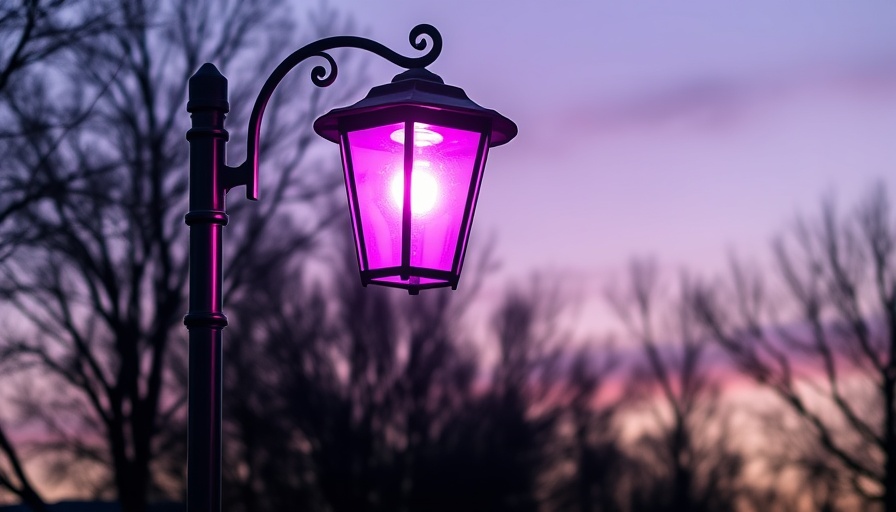
Understanding the Mystery of Purple Street Lights
As you drive through your neighborhood or navigate a new city, you might have noticed something peculiar in the streets—purple street lights. At first, it could seem like an odd trick of your imagination or perhaps a reflection, but these lights are becoming an unmistakable part of some urban landscapes. So, what exactly is happening with these curious illuminations?
What Causes Purple Street Lights?
Contrary to any mystical theories or urban legends, the purple hue emitted from some street lights can be attributed to simple manufacturing flaws. Lighting experts like Michele Lapicco note that these lights were initially intended to be standard white LED fixtures. However, a degradation in the phosphor coating over time reveals a cooler, purplish light beneath that was not the original design.
According to Alisha Kessler, a lighting product manager at Enbrighten, when this phosphor layer deteriorates—as seen in affected models produced around mid-2017—the result is a shift in the intended lighting color. This phenomenon isn’t isolated; it’s happening across various states due to widely used batches of LED street lights. Identifying the defective batches leads to proactive replacements, ensuring communities regain optimal street illumination.
Implications for Public Safety
Street lighting is crucial for safety, particularly during the nighttime. Therefore, understanding the impact of these purple lights on vision is essential. Experts warn that the purple LED light lacks the full-spectrum coverage characteristic of white light. This deficiency can distort color perception and hinder depth judgment, ultimately reducing visibility for drivers and pedestrians.
Lapicco emphasizes, "The purple glow might seem aesthetically pleasing, but clarity and safety on the road must take precedence. Distorted visibility can create hazards, especially in areas that already exhibit poor lighting conditions." Ensuring that communities replace defective street lights with high-quality alternatives will go a long way toward maintaining safety.
The Human Element: Community Reactions
As with any change in urban aesthetics, community responses to purple street lights are mixed. While some individuals appreciate the unusual vibe, others express concerns over safety. Take, for instance, the people living in neighborhoods with these faulty lights. How does it feel to traverse streets under a purplish glow? Many residents have voiced fears about accidents, feeling that the non-standard lighting might lead to a higher rate of incidents while navigating the roads.
For families, especially those with children or elderly members, these purple lights can be a cause for alarm. Urban environments are supposed to feel secure, and when lighting becomes an issue, it undermines that sense of safety. Encouraging dialogues between community members and city officials could lead to more informed and rapid replacements of problematic street lights.
Beyond the Aesthetic: Cultural and Environmental Factors
The color of street lights touches on broader themes of urban design and community values. Cities often strive to balance functionality with aesthetic beauty, yet the introduction of purple lights—as an unintended consequence—challenges this balance. Environmental factors also play a role; cities undertaking significant light retrofits to save energy may inadvertently install defect-ridden products. This emphasizes the importance of rigorous testing and quality assurance before widespread implementation.
Looking to the Future
As cities continue to upgrade their lighting systems for energy efficiency, addressing these manufacturing defects should be a key priority. With greater awareness of how degraded streetlights can affect visibility and safety, city planners can seek alternative, reliable options that avoid the pitfalls of the past.
Moving forward, it’s essential for communities to stress the importance of proper street lighting, not only for safety but to also retain the beauty of their neighborhoods. Engaging with local contractors and lighting experts can provide valuable insights for future projects. Homeowners, too, can advocate for quality lighting solutions that ensure their streets are not just well-lit, but also safe.
Take Action to Enhance Your Community
If you notice purple street lights in your area, don’t hesitate to reach out to your local government. Encouraging cities to prioritize replacement with high-quality street lighting is crucial not only for safety but for the aesthetic coherence of your community. Together, we can ensure that our streets remain vibrant and safe for everyone.
Understanding the reasons behind purple street lights is more than just a quirky curiosity—it can lead to actionable insights for enhancing the health and safety of our communities. Whether you’re a homeowner, contractor, or simply a concerned citizen, staying informed about such issues can empower you to become an active participant in improving your environment.
 Add Row
Add Row  Add
Add 




Write A Comment